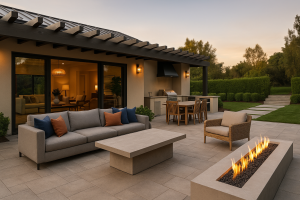As a pet owner, you know that your furry companions can bring joy and happiness to your life. However, they can also cause damage and chaos, especially when it comes to your plumbing system. From digging up pipes to chewing on cords, pets can cause significant harm to your plumbing fixtures and pipes, leading to costly repairs and potential hazards in your home.
That’s why it’s essential to take proactive steps to pet-proof your plumbing and prevent pet-induced damage. In this article, we’ll share five expert tips on how to protect your plumbing from pets, including securing access to plumbing areas, protecting exposed pipes and wires, providing pet-friendly alternatives, regular maintenance and inspections, and educating and training your pets for better plumbing safety.
Understanding the Risks of Pet-Induced Plumbing Problems
Pets are often the apple of their owner’s eyes, but when it comes to plumbing, they can be quite destructive. From chewing on pipes to scratching fixtures, pets can cause significant damage to plumbing systems, resulting in leaks, water damage, and costly repairs. As a responsible pet owner, it is essential to be aware of the potential risks that your furry friends pose to your plumbing and take proactive steps to prevent pet-induced plumbing problems.
Here are some of the common plumbing problems that pets can cause:
| Problem | Description |
|---|---|
| Chewing on pipes | Pets have a natural tendency to gnaw on things, and pipes might seem like an appealing target. However, their strong teeth can easily damage pipes, leading to leaks and other plumbing issues. |
| Scratching fixtures | Cats, in particular, are notorious for scratching everything in sight, including faucets, handles, and other plumbing fixtures. This can cause scratches, dents, or even breakages, depending on the material. |
| Accidentally causing blockages | Pets shed hair, leaves, and other debris that can accumulate in drains and cause blockages over time. Additionally, curious pets might drop toys or objects down the drain, causing clogs and backups. |
Tip 1: Secure Access to Plumbing Areas
One of the most effective ways to pet-proof your plumbing is by restricting your pet’s access to plumbing areas. Since many pets are naturally curious, they may venture into these areas, causing damage or blockages. To prevent this, consider implementing the following measures:
| Tip | Description |
|---|---|
| Close doors | Keep doors to bathrooms and utility rooms closed to prevent pets from entering. |
| Use childproof locks | If your pet can open doors, consider installing childproof locks to keep them out. |
| Install barriers | If you have a particularly determined pet, consider installing barriers, such as baby gates, to prevent access to certain areas. |
By securing access to plumbing areas, you can significantly reduce the risk of pet-induced plumbing problems and keep your pets safe from harm.
Tip 2: Protect Exposed Pipes and Wires
Exposed pipes and wires can be tempting targets for curious pets. Chewing, scratching, or pulling on them can cause significant damage to your plumbing system, resulting in leaks, floods, or electrical hazards. That’s why it’s essential to take steps to protect these vulnerable areas from pet-induced damage. Here are some tips:
| Tip | Description |
|---|---|
| Use Pipe Insulation | Insulating your pipes can prevent pets from chewing or scratching them. Foam pipe insulation or tubing can be easily applied to exposed pipes and fittings. Make sure to cut the insulation to fit snugly around the pipe and secure it with tape or wire. |
| Install Cord Protectors | Cords and wires can be protected by cord covers or protectors that can prevent pets from biting or pulling on them. These can be found at your local hardware store or online. Additionally, it is advisable to secure cables and cords to walls or other surfaces to discourage pets from playing with them. |
By implementing these pet-proofing solutions, you can minimize the risk of pet-induced damage to your plumbing system and avoid costly repairs. Remember to regularly inspect your pipes and wires and replace any damaged or worn-out insulation or protectors. With proper care and attention, you can keep your plumbing system safe and pet-friendly.
Tip 3: Provide Pet-Friendly Alternatives
One of the most effective ways to prevent pet-induced damage to your plumbing is to redirect your pet’s behavior towards more suitable alternatives. Offering pet-friendly toys and fixtures can help keep pets occupied and prevent them from damaging plumbing systems.
Here are some pet-friendly alternatives to consider:
- Chew toys: Provide your pet with plenty of chew toys to prevent them from gnawing on pipes or fixtures. Look for toys made of sturdy materials, such as rubber or nylon. Avoid giving pets toys that are too brittle or can easily break apart, as this can pose a choking hazard.
- Scratch posts: Cats love to scratch, and providing them with a suitable scratching post can prevent them from scratching fixtures or walls. Look for posts made of sisal or corrugated cardboard and place them near areas your cat likes to scratch.
- Interactive toys: Pets love toys that challenge their minds and keep them entertained. Consider investing in interactive toys, such as puzzle feeders or treat dispensers, that can keep your pet occupied for hours.
Remember to monitor your pet’s behavior and adjust their toys or fixtures as needed. If your pet shows a preference for certain items, make sure they have access to them. Providing suitable alternatives can help keep your plumbing safe and your pets happy.
Tip 4: Regular Maintenance and Inspections
Regular plumbing maintenance is essential for all homeowners, but it is especially important for those who have pets. By scheduling routine checks and inspections, you can identify potential issues before they escalate, and prevent pet-induced damage in the long run.
To ensure your plumbing stays in top shape, you should perform the following tasks regularly:
| Task | Description |
|---|---|
| Check for Leaks | Leaks can be caused by a variety of issues, such as corrosion, worn-out seals, or loose connections. If you notice any signs of water damage or damp spots around your home, call a professional plumber to assess the situation and repair any leaks. |
| Monitor Water Pressure | High water pressure can cause stress on your pipes and fixtures, leading to leaks or bursts. Use a pressure gauge to measure the water pressure in your home, and adjust it if necessary to prevent damage. |
| Clean Drains | Pet hair, food scraps, and other debris can accumulate in your drains and cause blockages. Use a drain cleaning solution or a plunger to remove any clogs and ensure water flows smoothly. |
In addition to these tasks, you should also consider scheduling regular plumbing inspections with a licensed professional. During these inspections, a plumber can identify any potential issues and recommend preventive measures to keep your plumbing pet-proof.
Tip 5: Educate and Train Your Pets
One of the best ways to prevent pet-induced plumbing problems is by educating and training your pets. By teaching them to avoid certain areas and behaviors, you can minimize the risk of damage to your plumbing fixtures and pipes. Here are some tips for pet training:
- Use positive reinforcement: Reward your pets for good behavior rather than punishing them for bad behavior. This will help them associate positive actions with positive outcomes.
- Be consistent: Train your pets regularly and consistently to reinforce good habits and discourage bad ones.
- Teach avoidance: Show your pets which areas they should avoid, such as under sinks or near pipes. Offer alternative areas for them to play or rest.
- Provide appropriate toys and scratching posts: Give your pets toys and scratching posts that are appropriate for their size and breed. This will redirect their attention away from plumbing fixtures and pipes.
- Recognize signs of distress: Observe your pets for signs of distress, such as scratching or pawing at fixtures. This can be a sign that they are experiencing discomfort or anxiety.
By implementing these tips, you can train your pets to be more aware of their surroundings and decrease their impact on your plumbing system. Remember to be patient and consistent, and seek professional help if needed.
FAQs about Pet-Proofing Your Plumbing
Q: Can I use pet-safe cleaning products in my drains?
A: Yes, using pet-safe cleaning products in your drains is a good idea. Many traditional cleaning products contain harsh chemicals that can damage pipes and may not be safe for your pets to ingest or inhale. Look for cleaning products that are labeled as safe for pets and the environment.
Q: What should I do if my pet causes a plumbing emergency?
A: If your pet causes a plumbing emergency, turn off the water supply immediately and call a professional plumber. Do not attempt to fix the problem yourself, as this can lead to further damage to your plumbing and potentially harm your pet.
Q: Are there any specific plumbing fixtures that are more pet-friendly?
A: Yes, there are certain plumbing fixtures that are designed to be more pet-friendly. For example, some toilets have a higher rim to prevent pets from drinking from them, and some faucet models have touchless or low-pressure features that can be easier for pets to use. Consider researching and investing in pet-friendly fixtures to minimize the risk of pet-induced plumbing problems.
Conclusion
Protecting your plumbing from pet-induced damage is not an option – it’s a necessity. By following the tips outlined in this guide, you can take proactive steps to safeguard your pipes, faucets, and drains from harm. Securing access to plumbing areas, protecting exposed pipes and wires, providing pet-friendly alternatives, conducting regular maintenance and inspections, and educating your pets are all essential components of pet-proofing your plumbing system.
Not only will these measures help you avoid costly repairs and water damage, but they will also provide a safer environment for your pets and family. Remember to be consistent and persistent in your efforts to train your pets and maintain your plumbing system. With some preparation and planning, you can have both happy pets and a healthy plumbing system.
Additional Resources for Pet-Proofing Your Plumbing
Ensuring that your plumbing is pet-proof is crucial for the safety of your pets and the longevity of your plumbing system. If you’re looking for more information about pet-proofing your plumbing, here are some resources to help you:
- Pet-Proofing Checklist: The American Kennel Club offers a comprehensive checklist for pet-proofing your home, including your plumbing system. The checklist covers everything from securing pipes to preventing electrical hazards.
- Pet-Safe Plumbing Products: If you’re looking for pet-safe plumbing products, the Humane Society provides a list of approved products that you can use to keep your furry friends safe.
- Plumbing Maintenance Guide: The National Association of Home Builders offers a plumbing maintenance guide that includes information on how to keep your plumbing in good condition, as well as tips for preventing pet-induced plumbing problems.
- Pet Training Resources: If you need help training your pets to avoid damaging your plumbing, the ASPCA offers a range of resources, including guides and training classes, to help you train your pets effectively.
By utilizing these resources, you can ensure that your plumbing is pet-friendly and safe for your furry friends. Remember, taking proactive steps to pet-proof your plumbing can save you time and money in the long run, while also keeping your pets safe and healthy.
FAQ
Q: Can I use pet shampoo to clean my plumbing fixtures?
A: While some pet shampoos may be safe for use in drains, it is always best to consult with a professional plumber before using any type of cleaning agent. Harsh chemicals or abrasive substances can damage pipes and fixtures, potentially causing leaks or blockages.
Q: What should I do if my pet damages my plumbing?
A: If your pet causes damage to your plumbing, it is important to address the issue immediately to prevent further damage. Contact a licensed plumber to evaluate the problem and provide a solution. In some cases, you may need to file a claim with your insurance company to cover the cost of repairs.
Q: Are there any specific plumbing fixtures that are more pet-friendly?
A: There are several plumbing fixtures that are designed with pets in mind, such as non-slip bathtubs, handheld showerheads, and elevated feeding stations. Speak with a plumbing professional to discuss your options for pet-friendly fixtures and the best ways to integrate them into your home.










